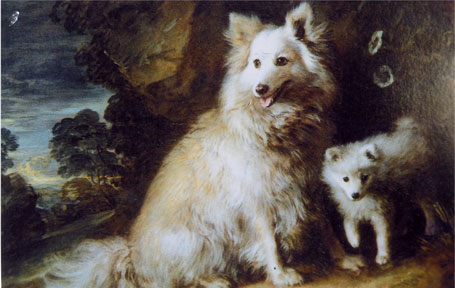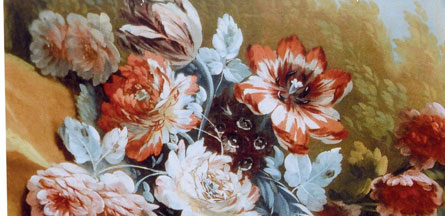British art in retrospect
by Gwen Herat
The absolutely scruffy, stuffy, boring British art is still at its
snail's space and seldom seems to put up any form of momentum. I have
seen little change over the past three to four decades, not even in the
spirit of colour mix-up. Bulk of the paintings still adorn sombre and
pathetic colour combinations.
Why?
I cannot fathom but I must confess there is an element of strong
character in figure-portraiture that almost perfect and very English.
All British painters stamp their identity on their aat and leave a
signature behind which is very remarkable.
 |
|
Pomeranian and puppy (1771): At the
Tate Gallery, London. A striking tribute to man's best
friend by Gainsborough, one of England's celebrated masters
who put British art in the forefront. |
Painting is a principal concern of many artistic people in Britain
but in narrative form, is often considered in terms of national history.
Art in Britain functions like Britain itself, given into a state of
flux. The Church has been very significant if not the sole patron of the
arts. One look at the churches' stained-glass paintings is ample proof
of this theory.
Hans Holbein's success as the court painter of Heny VIII, came to
England imbued with Italian and European influence as his early
paintings indicated but he left no stylist successors and the court's
next principal painters to emulate his legacy came from abroad. Among
them van Dyck stood out boldly. He evoked an effortless sense of royalty
and aristocratic innate in pose and gesture.
He eclipsed his foreign predecessors and the speed and delicacy with
which he painted, his facility with oil on canvas and his eye for
detail, well informed by travel experience, made him stand out among
all. Painting had much to do with heir kings and the courts and the
painter who ended up at the court of any monarch, reached his climax in
his chosen art.
Irrevocable change
The accession of William of Orange to the English throne along with
its shake-up of the old order wrought irrevocable change in the art
scene. It was gradual and by the time the effects were bared, the order
had changed.
Painters were painting a new style in colour and play of light. Came
Hogarth; He changed the mood of British painting and beat the national
contemporary drum to formulate the establishment of Royal Academy and
the British School of painting.
Presently there is an extraordinary wealth of paintings done by the
past masters as well as by modern ones. This dispels the belief that the
British painter lacks and lacked a strong visual imagination. By
painting varied subjects over the years, he has proved the artistic and
philosophical development of British art.
He also reveals the history of his art journey that began in the
Middle Ages. Happily it ended in the beginning of the new millennium.
He has inherited the legacy left behind by icons such as hans
Holliben and Antony van Dyck. Later, by Gainsborough Reynolds and
Hogarth from the 18th century. Constable, Turner, Sisley and the
Pre-Raphaelites from the 19th century and some of the leading artists
from the 20th century.
At the beginning of the eighteenth century the art of England had
become degraded. The fault lay in the hands of Kneller whose weak and
false art that he painted in portrait, flattered only the sitters.
Unfortunately, the style that van Dyck had left behind had not survived
two generations.
Came Hogarth whose sincerity with sarcasm uprooted the sickly boring
face from the existing canvasses. Were it not for him even English
portraiture would have suffered the same fate.
England's golden age
Hogarth's pen helped his brush to describe the unpleasant realities
and fiercely brushed aside Kneller's false contribution that made many
art lovers pull down his canvases from their walls. Hogarth gave the
message of true English art to art lovers using his pen forcefully and
made them face the truth, study the fine art of England so sincere and
healthy that resulted a quick turnaround.
 |
|
Still life of flowers
by Mary Moses (1744-1819) At the Bridgeman Art Gallery. |
Art lovers studied all forms of classicism that helped them identify
the icon Masters and follow their traits. In the wake, came Sir Joshua
Reynold and though he was different from Hogarth, together they both
founded the English School. Hence, the English genius stayed at home,
flowered and reached their height to sky level and did not need any
foreign influence to paint for them.
Reynold led the rest as the head of group portrait and landscape
painters who were the glory of the eighteenth century. The work of all
these painters and the once who followed them in hot pursuit share the
complete and final revelation the nation's soul. But, it paused there
when Reynolds and Gainsborough laid down their brushes and passed into
long silence.
Illustrious career
The fine minds of Reynolds and Gainsborough who were great artists
and thinkers, did not give the stressful care for their subjects that
Sir Joshua did.
Reynolds took a long time to establish his genius while Gainshorough
jump-started his illustrious career. Gainsborough's matchless portrait
of Mrs. Graham is matchless and it hangs in the Scottish National
Gallery, Edinborough. As for me, I swear by the one painted by Reynolds,
of Mrs. Siddons, the immortal muse of all Shakespeare characters.
The eighteenth century portrait painters were all colourists and were
not afraid of putting on canvas the clear and glowing shades which they
thought to be best. None were following any particular school of art
which made Reynolds and Gainsborough the icons of their era.
Unlike in the case of Reynolds, much of Gainsborough's works are
treasured by private owners. Many originals are not seen by the public
as their owners had taken them overseas. They had to be satisfied with
only duplicates.
The famous 'Blue Boy' had gone to America. 'The Morning Walk.... Mrs.
Stone Norten, ... Mrs. Sheriden, ... Miss. Lenley and Her Brother ...
are not available to the public except as reproductions. Mrs. Robinson
as Perdita (a Shakespeare character that I made very effort to see even
in reproduction and failed and Mrs. Haverfield along with sixteen more
Gainsboroughs, hang in the National Gallery. Eight paintings are in the
National Portrait Gallery. Five in the South Kensington Gallery, six in
the Dulvich Gallery and many more in the British Museum.
|

